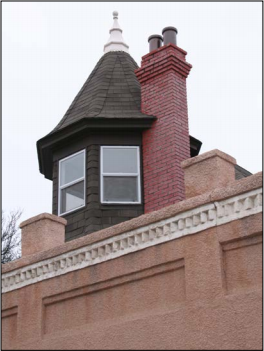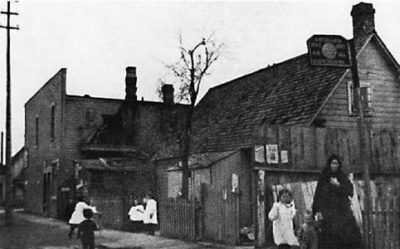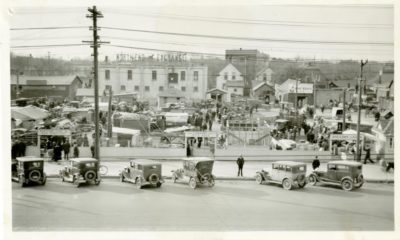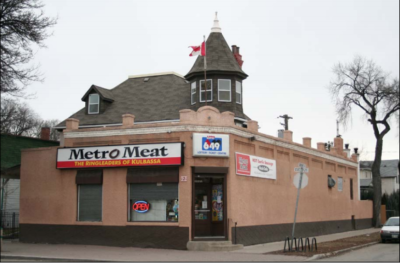
/ Blog
March 13, 2020
The Ringleaders of 121 Euclid Avenue
At 121 Euclid Avenue, a curiously shaped corner store wraps around a detailed Queen Anne Revival style home. Inside, at Metro Meat, you can find a fine sampling of deli meats and experience a part of Point Douglas’s physical and cultural landscape that has been in operation since 1911.
The home was the first part of the structure to be built, in 1899, for the McKiechan family. Not much is known about the McKiechan family, nor the home’s architect or contractor. Even without this information though, the house is clearly a wealth of ornamentation. Typical of the late 1890s, the home is built in the eclectic Queen Anne Revival style – which combines architectural styles to create an asymmetrical and picturesque façade. White stuccoed walls contrast with the green window-frames and detailing along the roofline. A single turret and a dormer jut out of the green shingled roof.
 |
| Details of roofline, and the corner tower of the house. Source: Murray Peterson, City of Winnipeg. |
The McMiechan family sold the home in 1906 to developer J.A. Dart, who in turn rented the home out to a variety of tenants for the next five years. In 1911, Simon and Annie (nee Rossler) Matas purchased the three-storey home at Euclid Avenue. This would become their first and only family home in Winnipeg. Both Simon, Annie, and Simon’s brother Matthew all came to Winnipeg fleeing anti-Semitic persecution in Imperial Russia (now the Ukraine)– though each journey was slightly different.
Matthew Matas was the first to arrive in 1905. Fleeing the military draft, poverty, and increasingly violent attacks of Jewish communities, Matthew found refuge in Winnipeg’s North End. By this point in time, Winnipeg’s North End (a broad term that encompasses several other neighbourhoods including Point Douglas) was a hub for Eastern European immigrant settlement.
 |
| Winnipeg’s “Foreign Quarter” in the early 1900s. Source: Province of Manitoba Archives. |
Meanwhile, Simon’s way out of Russia looked a little different. After being drafted into the Russo-Japanese War in 1905, Simon decided to make his escape and booked a passage to England. While Anna Rossler was not drafted into a war, she too fled to England in 1905.
It would still take months for Anna and Simon to meet, and the first time they did it was brief. According to a family history written by David Matas, Simon first saw Anna while seeing a movie. Though the pair never spoke and he did not know her name, Simon later proclaimed to a friend that Anna “was the most beautiful woman he had ever seen, and was going to marry”.
In a happy twist of fate, another friend set Simon up on a blind date with the very same woman and they began dating. By 1907, the couple decided to join Matthew in Winnipeg. Simon arrived first, taking up work at a north end deli, and Anna joined a year later in 1908. Anna and Simon were married in 1909, and would have six children together between 1909-1920. The growing family prompted Anna and Simon to purchase the home at 121 Euclid Avenue.
By this point, Euclid Avenue had become the unofficial main street of Point Douglas. There were some 20 small businesses on Euclid, with others scattered out onto the side streets, and the neighbourhood was a bustling multi-cultural hub. These shops were largely corner grocery stores, which were prominent in Winnipeg in the days before big superstores like Walmart and Sobeys.
 |
| The North End farmer’s market, seen here in 1931, was also a reliable grocery shopping option in the days before bigger stores. Source: City of Winnipeg Past Present. |
Looking to get into the grocery game, the Matas family pooled their resources together and hired David Abramovich to construct a commercial addition to 121 Euclid Avenue in 1911. Similar to the Matas family, Abramovich was new to Winnipeg. He had immigrated from Bucharest, Romania, in 1906 and quickly took up work as a local architect. Abramovich is one the first Jewish architects to practice in Winnipeg, and generally focused on the construction of three storey walkup apartments. Some of his designs can still be found near Corydon Avenue, namely the King George Court on Cockburn and Kitchener Court along McMillan.
The one storey commercial building at 121 Euclid is something of an anomaly for Abrmovich. When it opened in 1911, it housed the Matas Brothers Grocer and Pool Hall which was owned and operated by Simon and Matthew. The exterior brick walls are clad in stucco, and the bulk of the ornamentation can be found along the roofline with its recessed panels and chimney-like projections. For a short period after opening, a barbershop also operated inside the space, but by 1925 the store exclusively sold groceries and meat.
Matthew Matas eventually left Winnipeg, though Simon continued to operate the store for the next forty years. His six children grew up and moved out, and his sons Harry and Roy took jobs as a physician and a judge respectively. Anna passed away in 1954, and Simon sold his store not long after. He moved in with his son Harry, and later into a retirement home.
This was not the end of 121 Euclid Avenue. By the 1950s-60s, corner stores were beginning to close as larger grocers began to open. Increased car usage also drew locals away from the little mom-and-pop shops, and slowly but surely the stores on Euclid began to close. The former Matas Brothers Grocers was instead bought by Walter Tarnowski in the 1960s and renamed the store the Euclid Meat Market.
Today, the store is still in operation as Metro Meat and is the last remaining corner grocery store of Euclid Avenue. The City of Winnipeg prepared a report on the history of the building in 2007, and subsequently placed the building on the Commemorative Historical Resources list. Unlike granting a building heritage designation, the Commemorative List offers nothing in the way of protection.
When the Commemorative List was created in 2014, heritage advocates protested the lack of offered protection. Heritage Winnipeg and the Manitoba Historical Society both argued that the designation was little more than a consolation prize with little in the way of tangible benefits. As of March, 2020, there are 349 buildings on the Commemorative List. For comparison, there are 353 protected heritage buildings in Winnipeg.
 |
| 121 Euclid Avenue, seen in 2007. Source: Murray Peterson, City of Winnipeg. |
Fortunately for the moment, it appears as if little protection is needed for this cultural icon. On its fourth owner in the past 110 years, Metro Meat remains an important corner stone of the cultural history of Euclid Avenue and is still, as its sign proclaims, “the ringleaders of kulbassa”!
SOURCES:
121 Euclid Avenue | City of Winnipeg Commemorative List of Historical Resources
Matas Family History | David Matas
Ringleaders for 99 Years | The Commons
Winnipeg’s Preservation Puzzle | Winnipeg Free Press, 08/9/2019
Historical Tours in Manitoba: Walking Tour of North Point Douglas | Manitoba Historical Society
David Abramovich | Dictionary of Canadian Architects
272 Cockburn Street | City of Winnipeg List of Of Historical Resources
THANK YOU TO THE SPONSOR OF THIS BLOG POST:

Written by Sabrina Janke on behalf of Heritage Winnipeg.












the blogs are terrific, keep up the good work.
Great article thanks for sharing!
Wow. I’m glad to see Metro Meats is still in operation. When I was young and single and living on Pritchard Ave in the mid-1970s I often shopped there for their lazy-man’s no-cooking-required studenetz (a.k.a. headcheese).